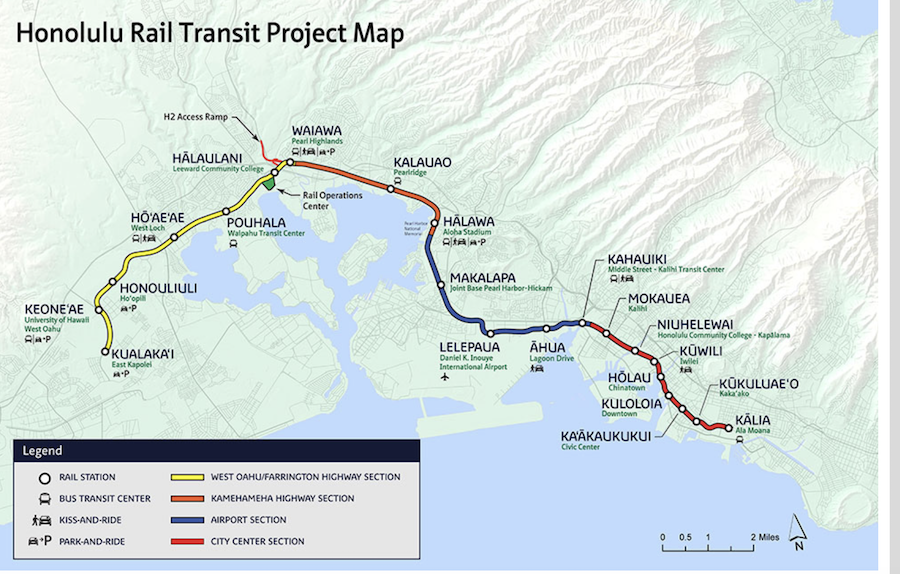Bidders for Aborted Honolulu Rail P3 Are Finally Revealed

City Center section of Honolulu light rail system (in red) was intended to be built under a P3 arrangement. Map courtesy of HART
A proposed public-private partnership to complete Honolulu’s troubled light-rail system may be off the table due to pushback from city officials, but it is still making news as local transit officials have finally identified the two teams that bid on the project this summer.
City Center Construction Group—led by Dragados, Hawaiian Dredging Construction Co., and Obayashi Design Group, and Imua Transit Honolulu—with Tutor Perini and Parsons Corp. as major partners—each submitted bids in late July for a 30-year concession to design, build, operate and maintain the last four-mile, eight-station segment of the 20-mile elevated transit line, which to date has been funded by a Federal Transit Administration grant and local tax revenue.
City officials and those from the Honolulu Authority for Rapid Transportation (HART), which is overseeing the project, initially declined to identify the bidders or their prices until contract award, originally scheduled for late September.
But in ensuing weeks, the city became less supportive of the P3 approach, as bids reportedly far exceeded HART’s $1.4-billion estimate for the segment.
The same month as the bids were submitted, Tutor Perini Chairman and CEO Ronald Tutor announced during the company’s second-quarter earnings call that his team had bid more than $2 billion for the assignment, although it’s unclear whether that figure included operations and maintenance.
HART has yet to disclose bid details, citing an unnamed team’s concerns regarding public release of its price proposals.
Although the city eventually withdrew from the P3, HART CEO Andrew Robbins continued to advocate for the approach until agreeing in early November to pursue a different project delivery strategy.
City Center Connection Group’s other members included Rizzani De Eccher USA, DTL Builders, The Wilhelm Group, Dan Brown and Associates, Systra International Bridge Technologies and Zephyr UAS, Inc.
Imua Transit Honolulu’s main subcontractors included Granite Construction Co, and Traylor Bros.
Since construction got underway in 2012, utility relocations and other cost-contributing delays have gradually pushed the project’s total pricetag to nearly double HART’s original $5.2 billion estimate, with the agency now forecasting completion in 2026.
Honolulu Mayor Kirk Caldwell, who has been odds with the agency over the P3 approach, suggested in November that a phased procurement using funding as it becomes available would help contain further cost increases, albeit with a slower pace of construction that could last into 2033.
For now, HART is scrambling to maintain funding resources it already has, appealing for an extension of a $250-million Federal Transit Administration tranche for rail construction that is scheduled to expire on Dec. 31.


